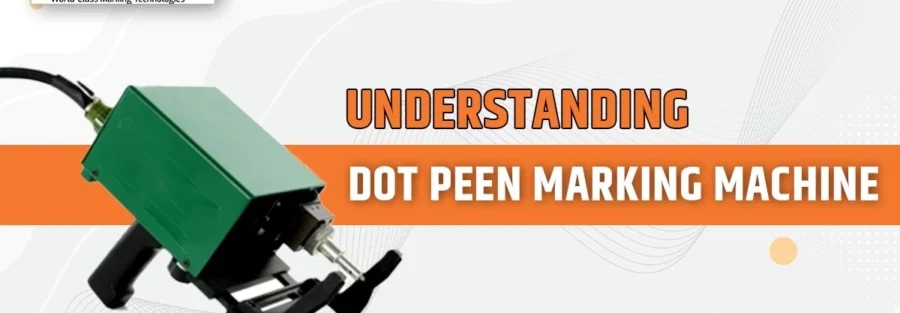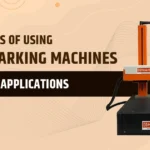Dot peen marking machines are tools used to make permanent marks on materials by creating a series of dots on their surface. Unlike other methods that may remove material, dot peen marking gently moves the metal to form the dots, making it safer and more precise. These machines are widely used in various industries to mark products with important information such as serial numbers, barcodes, and logos. In this guide, we will explore how dot peen marking machines work and the benefits they offer in creating durable and accurate markings on different types of materials.
Understanding Dot Peen Marking Machines
Dot peen marking machines are sophisticated tools used across industries to create permanent markings on various materials. This article aims to provide a comprehensive understanding of dot peen marking machines, including their functionality, applications, advantages, and considerations.
What is Dot Peen Marking?
Dot peen marking, also known as dot pin marking or dot matrix marking, is a process that involves using a stylus or pin to create indentations or dots on a material’s surface. These dots form alphanumeric characters, logos, or other symbols, providing permanent identification and traceability.
How Dot Peen Marking Machines Work
Dot peen marking machines utilize a combination of mechanical and pneumatic components to create marks on materials. The process typically involves the following steps:
Design Input: The operator inputs the desired marking design into the machine’s software interface. This includes specifying the content, size, and placement of the marks.
Positioning: The material to be marked is positioned securely within the machine’s marking area, ensuring accuracy and consistency.
Marking: The machine’s stylus, or pin, moves across the material’s surface according to the programmed design, creating a series of dots. These dots form the desired marks, such as alphanumeric characters or symbols.
Depth and Speed Control: Dot peen machines offer control over the depth and speed of the marking process, allowing for customization based on the material type and desired mark characteristics.
Applications of Dot Peen Marking Machines
Dot peen marking machines find applications across a wide range of industries, including:
- Automotive: Marking serial numbers, VIN codes, and part numbers on automotive components for traceability and quality control.
- Aerospace: Identifying parts, tools, and equipment with serial numbers, part numbers, and barcodes for maintenance and safety purposes.
- Manufacturing: Marking product identification information, including logos, batch numbers, and date codes, on various manufactured goods.
- Electronics: Engraving serial numbers, logos, and model numbers on electronic components for branding and traceability.
- Medical: Marking medical devices, implants, and instruments with regulatory information, lot numbers, and manufacturing details for compliance and tracking.
Advantages of Dot Peen Marking Machines
Dot peen marking machines offer several advantages over alternative marking methods:
- Permanent Markings: Dot peen markings are durable and resistant to wear, ensuring long-lasting identification and traceability.
- High Precision: These machines can create precise marks with consistent dot placement, even on curved or irregular surfaces.
- Versatility: Dot peen marking machines can mark a wide range of materials, including metals, plastics, ceramics, and composites.
- Speed and Efficiency: Dot peen machines can mark quickly and efficiently, making them suitable for high-volume production environments.
- Cost-Effectiveness: Compared to other marking methods, dot peen marking offers a cost-effective solution for permanent identification and traceability.
Considerations When Choosing a Dot Peen Marking Machine
When selecting a dot peen marking machine, consider the following factors:
- Marking Area Size: Ensure that the machine’s marking area is suitable for the size of the materials to be marked.
- Marking Depth and Speed: Choose a machine with adjustable marking depth and speed settings to accommodate different material types and marking requirements.
- Integration Capabilities: Consider whether the machine can be integrated into existing production lines or workflows for seamless operation.
- Software Compatibility: Ensure compatibility with design software and file formats for easy design input and customization.
- Durability and Reliability: Select a machine from a reputable manufacturer known for producing durable and reliable marking equipment.
Conclusion
Dot peen marking machines are versatile tools used for creating permanent markings on materials across various industries. Understanding their functionality, applications, advantages, and considerations is essential for selecting the right machine to meet specific marking requirements. With their ability to provide durable, precise, and efficient markings, dot peen marking machines play a crucial role in product identification, traceability, and quality control.
FAQs
1. How does a dot peen marking machine work?
Dot peen marking machines use a pin to strike the material’s surface, creating a series of dots that form letters, numbers, or other patterns.
2. What materials can be marked using dot peen marking machines?
Dot peen marking machines can mark various materials, including metals, plastics, and ceramics.
3. What are the benefits of using dot peen marking machines?
Dot peen marking machines offer several benefits, including durability, accuracy, versatility in marking surfaces, and high-speed operation.
4. Where are dot peen marking machines commonly used?
Dot peen marking machines are commonly used in industries such as automotive, aerospace, medical, and manufacturing for marking products with important information like serial numbers, barcodes, and logos.
5. How do dot peen marking machines compare to other marking methods?
Dot peen marking machines are preferred over other methods like acid etching or lasers because they create marks without removing material, making them safer and more precise.





